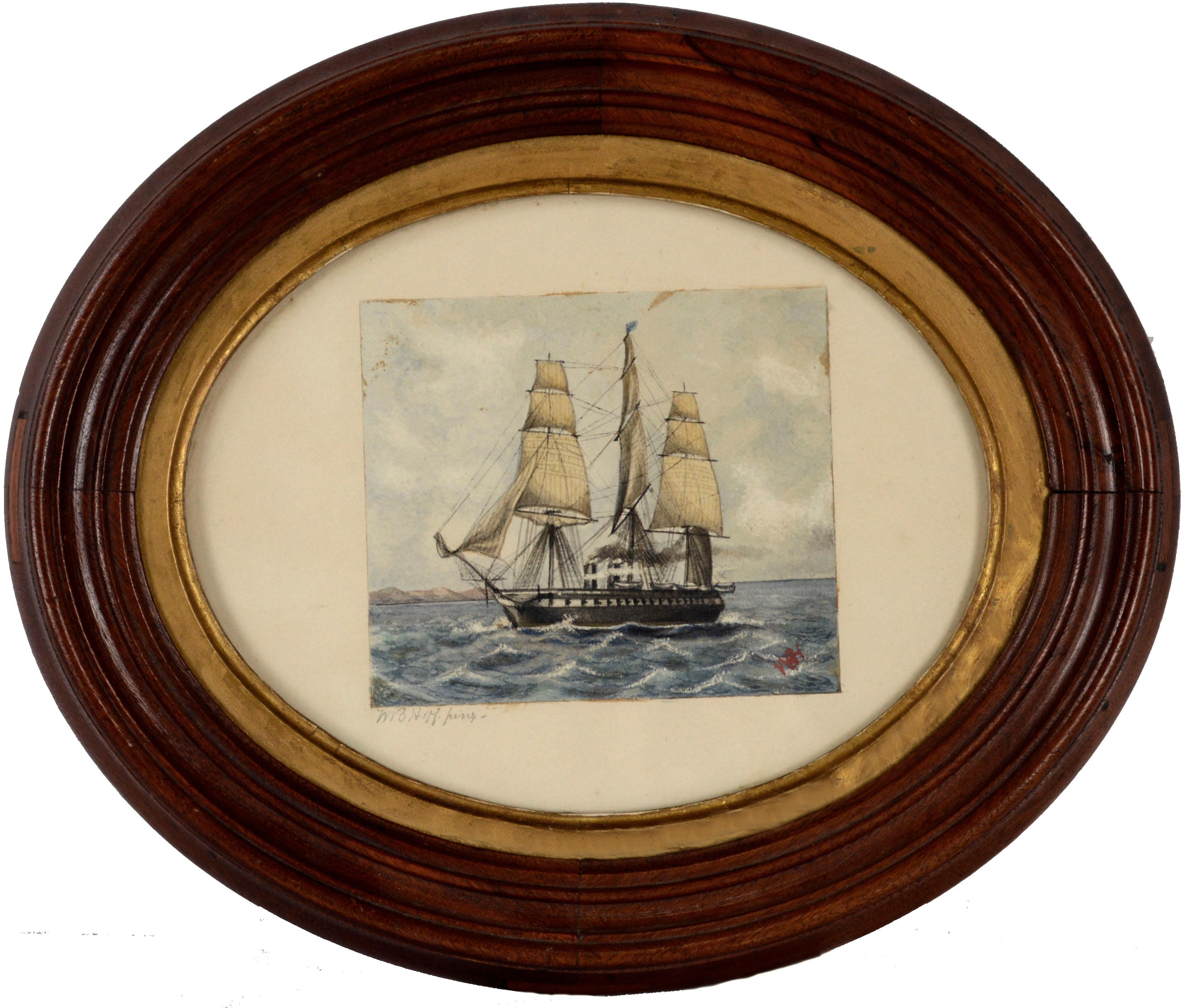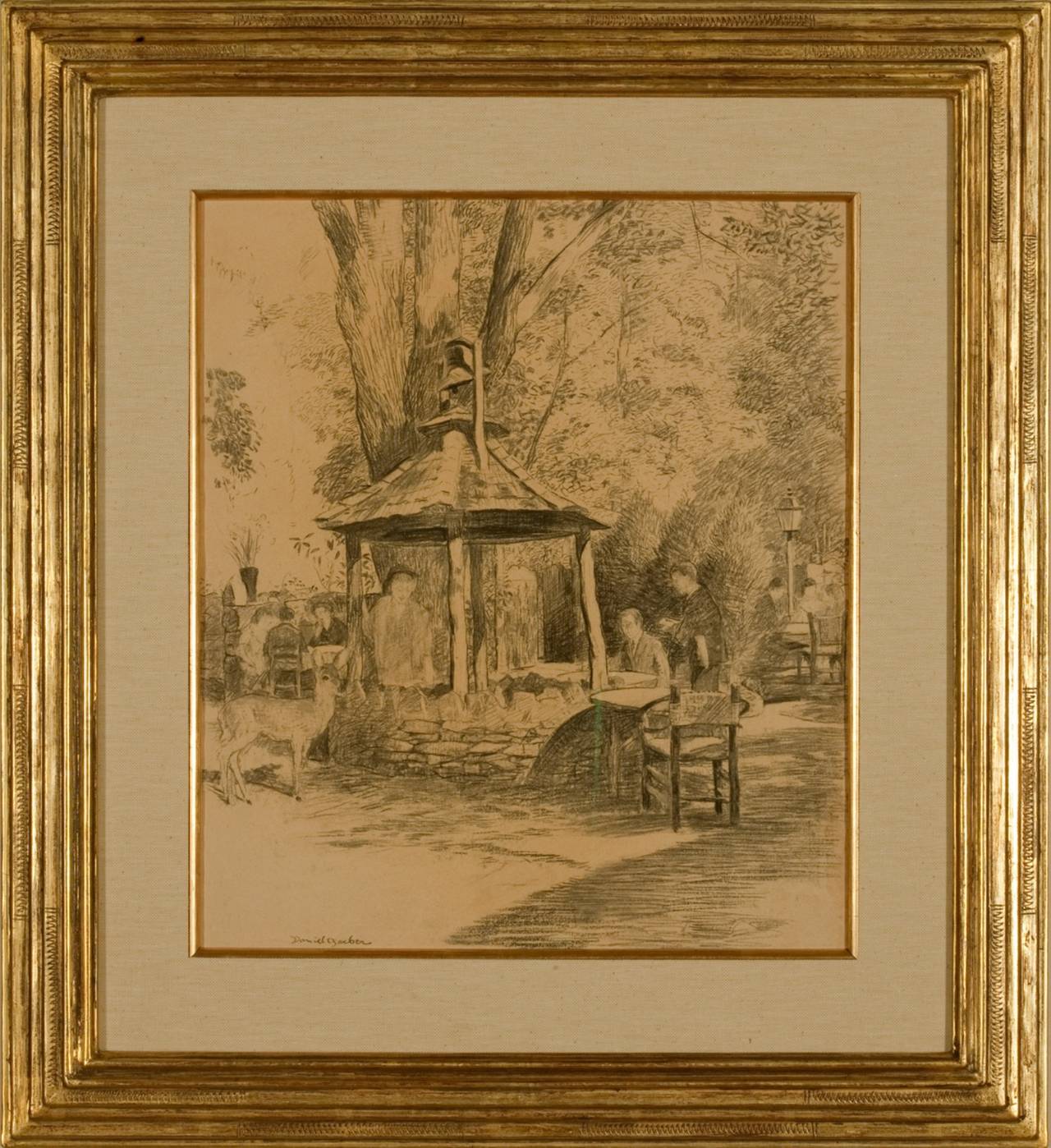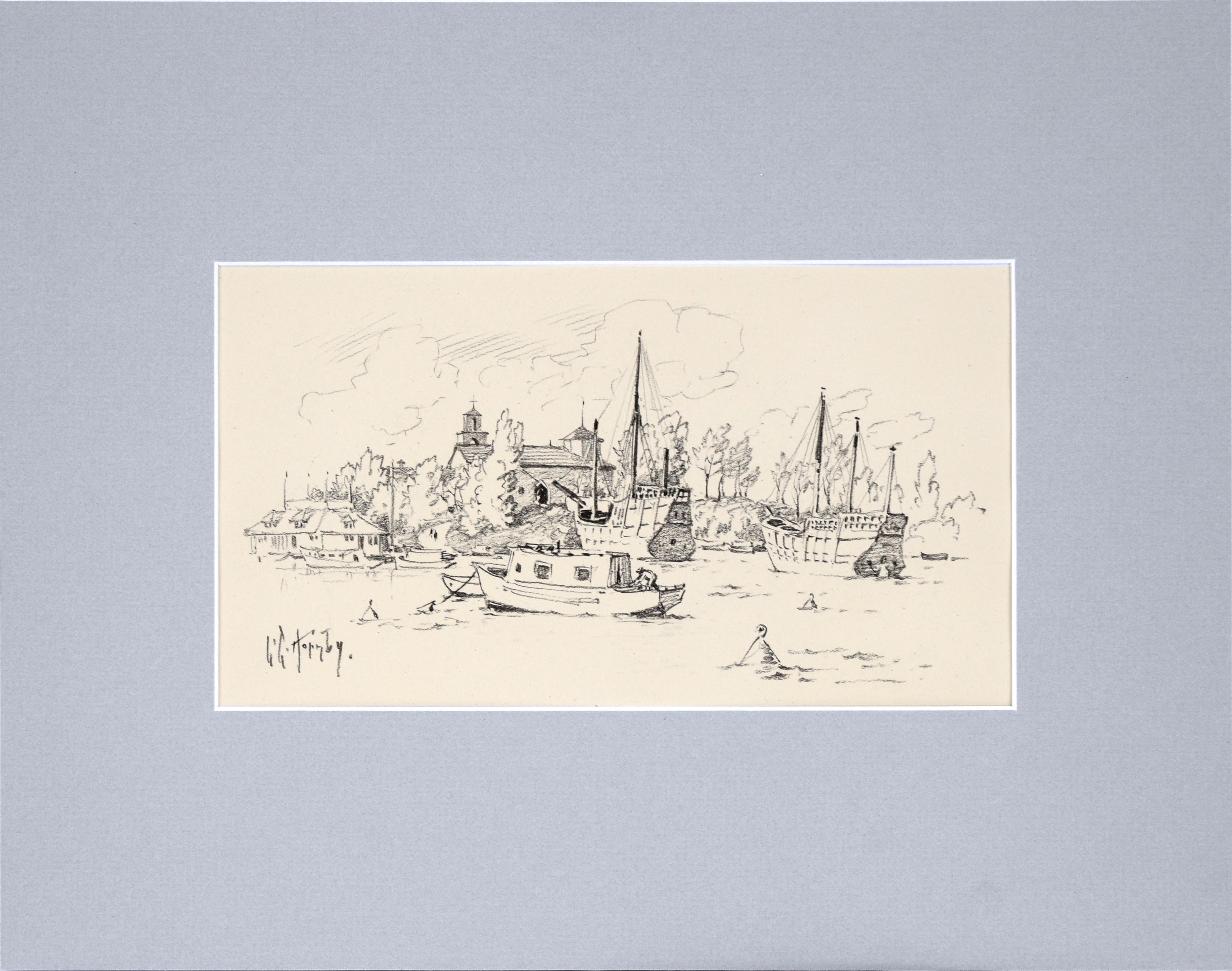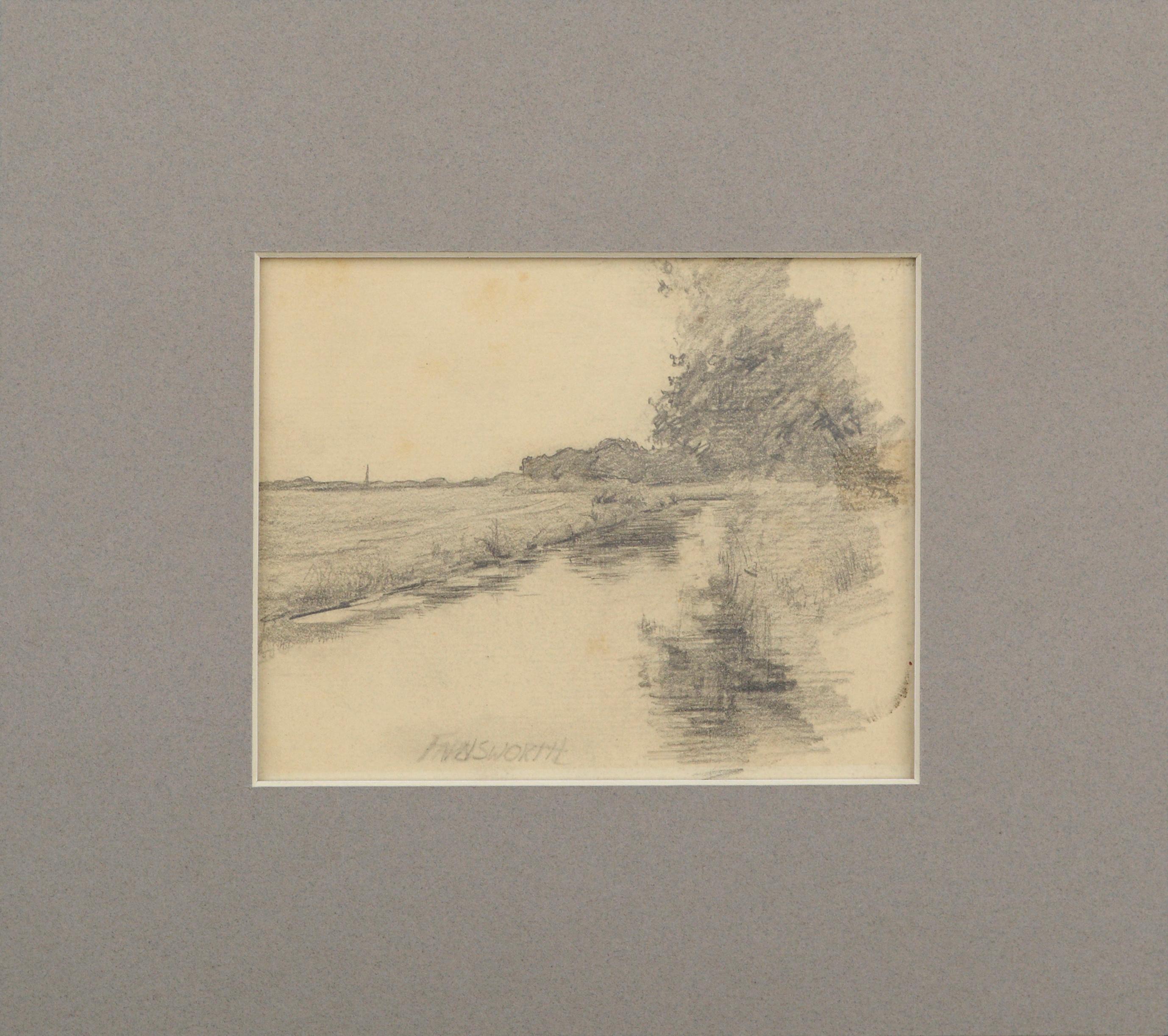Items Similar to "Horse Cart"
Want more images or videos?
Request additional images or videos from the seller
1 of 3
Daniel Garber"Horse Cart"c. 1906 - 1907
c. 1906 - 1907
About the Item
Jim’s of Lambertville Fine Art Gallery is proud to present this piece by Daniel Garber (1880 - 1958).
One of the two most important and, so far, the most valuable of the New Hope School Painters, Daniel Garber was born on April 11, 1880, in North Manchester, Indiana. At the age of seventeen, he studied at the Art Academy of Cincinnati with Vincent Nowottny. Moving to Philadelphia in 1899, he first attended classes at the "Darby School," near Fort Washington; a summer school run by Academy instructors Anshutz and Breckenridge. Later that year, he enrolled at the Pennsylvania Academy of the Fine Arts. His instructors at the Academy included Thomas Anshutz, William Merritt Chase and Cecilia Beaux. There Garber met fellow artist Mary Franklin while she was posing as a model for the portrait class of Hugh Breckenridge. After a two year courtship, Garber married Mary Franklin on June 21, 1901.
In May 1905, Garber was awarded the William Emlen Cresson Scholarship from the Pennsylvania Academy, which enabled him to spend two years for independent studies in England, Italy and France. He painted frequently while in Europe, creating a powerful body of colorful impressionist landscapes depicting various rural villages and farms scenes; exhibiting several of these works in the Paris Salon.
Upon his return, Garber began to teach Life and Antique Drawing classes at the Philadelphia School of Design for Women in 1907. In the summer of that same year, Garber and family settled in Lumbertville, Pennsylvania, a small town just north of New Hope. Their new home would come to be known as the "Cuttalossa," named after the creek which occupied part of the land. The family would divide the year, living six months in Philadelphia at the Green Street townhouse while he taught, and the rest of the time in Lambertville. Soon Garber’s career would take off as he began to receive a multitude of prestigious awards for his masterful Pennsylvania landscapes. During the fall of 1909, he was offered a position to teach at the Pennsylvania Academy as an assistant to Thomas Anshutz. Garber became an important instructor at the Academy, where he taught for forty-one years.
Daniel Garber painted masterful landscapes depicting the Pennsylvania and New Jersey countryside surrounding New Hope. Unlike his contemporary, Edward Redfield, Garber painted with a delicate technique using a thin application of paint. His paintings are filled with color and light projecting a feeling of endless depth. Although Like Redfield, Garber painted large exhibition size canvases with the intent of winning medals, and was extremely successful doing so, he was also very adept at painting small gem like paintings. He was also a fine draftsman creating a relatively large body of works on paper, mostly in charcoal, and a rare few works in pastel. Another of Garber’s many talents was etching. He created a series of approximately fifty different scenes, most of which are run in editions of fifty or less etchings per plate.
Throughout his distinguished career, Daniel Garber was awarded some of the highest honors bestowed upon an American artist. Some of his accolades include the First Hallgarten Prize from the National Academy in 1909, the Bronze Medal at the International Exposition in Buenos Aires in 1910, the Walter Lippincott Prize from the Pennsylvania Academy and the Potter Gold Medal at the Art Institute of Chicago in 1911, the Second Clark Prize and the Silver Medal from the Corcoran Gallery of Art for “Wilderness” in 1912, the Gold Medal from the Panama-Pacific Exposition in San Francisco of 1915, the Second Altman Prize in1915, the Shaw prize in 1916, the First Altman Prize in 1917, the Edward Stotesbury Prize in1918, the Temple Gold Medal, in 1919, the First William A. Clark Prize in 1921, the Gold Medal from the Philadelphia Art Club in 1923, the Carnegie Institute Bronze Medal in 1924, the Gold Medal of Honor in 1929, the Jenny Sesnan Gold Medal in 1937, the Pennell Medal in 1942, and the Pennsylvania Academy Fellowship Award in1947 among many others.
Daniel Garber and Edward Redfield are known by most art enthusiasts as the two leading figures associated with the New Hope Art Colony. This is a correct assessment, but in the broader scope, as key figures in twentieth century American Art, their importance is equally paramount. As this group, once considered regional, secures it’s place in history, painters like Garber and Redfield are destined to be considered the true American Masters by the international art world.
Garber's work is included in nearly thirty museum collections nationally and this number is growing. He is also the first of the "New Hope School" painters to exceed the million dollar mark at auction which occurred in 2003.
- Creator:Daniel Garber (1880-1958, American)
- Creation Year:c. 1906 - 1907
- Dimensions:Height: 8 in (20.32 cm)Width: 14 in (35.56 cm)
- Medium:
- Movement & Style:
- Period:
- Condition:
- Gallery Location:Lambertville, NJ
- Reference Number:
About the Seller
5.0
Vetted Seller
These experienced sellers undergo a comprehensive evaluation by our team of in-house experts.
Established in 1997
1stDibs seller since 2014
36 sales on 1stDibs
Typical response time: 6 hours
- ShippingRetrieving quote...Ships From: Lambertville, NJ
- Return PolicyThis item cannot be returned.
More From This SellerView All
- "Central Park"By William Langson LathropLocated in Lambertville, NJJim’s of Lambertville is proud to offer this artwork. Signed. Complemented by a hand carved and gilt frame. William L. Lathrop (1859-1938) Deemed “Father of the New Hope Art Colony”, William Langson Lathrop was born in Warren, Illinois. He was largely self-taught, having only studied briefly with William Merritt Chase in 1887, at the Art Students League. Lathrop first moved east in the early 1880s, and took a job at the Photoengraving Company in New York City. While there, he befriended a fellow employee, Henry B. Snell. The two men became lifelong friends and ultimately, both would be considered central figures among the New Hope Art Colony. Lathrop's early years as an artist were ones of continuing struggle. His efforts to break through in the New York art scene seemed futile, so he scraped enough money together to travel to Europe with Henry Snell in1888. There he met and married an English girl, Annie Burt. Upon returning to New York, he tried his hand at etching, making tools from old saw blades. Even though his prints were extremely beautiful, he still was impoverished. Lathrop would return to his family in Ohio, before once again attempting the New York art scene. In 1899, with great trepidation, he submitted five small watercolors to an exhibit at the New York Watercolor Club. He won the Evans Prize, the only award given, and four of the five paintings were sold the opening night. At age forty Lathrop’s career would finally take off and he became an “overnight success Lathrop came to Phillips Mill for the first time in1898, to visit his boyhood friend, Dr. George Marshall. Shortly after, he and his family purchased the old miller’s house from Dr. Marshall. The Lathrop’s home became a social and artistic center for the growing New Hope colony. Tea and fascinating conversation was the “order of the day” every Sunday. This was a scene fondly recalled by many younger art students that Lathrop taught privately at Phillips Mill. It was common to see groups of his students painting and sketching along the banks of the canal or aboard his canal boat. He had previously taught in the Poconos and at the Lyme, Connecticut Summer School in1907, but Phillips Mill always remained Lathrop’s permanent address. In 1928, a committee headed by Lathrop was formed to purchase the old Phillips Mill building as a place to hold community gatherings and art exhibitions. The committee had success and in 1929 the Phillips Mill Community Association was formed. This became the center of the New Hope Art Colony holding annual exhibitions and still operating today. In 1930, Lathrop had built a sailboat he named the “Widge”. For eight consecutive seasons he sailed it along the coast of Long Island...Category
Early 20th Century American Impressionist Landscape Drawings and Waterco...
MaterialsPaper, Graphite
- "Lunch at the Stockton Inn"By Daniel GarberLocated in Lambertville, NJJim’s of Lambertville is proud to offer this artwork. Signed lower left. Pencil drawing. Complemented by a hand carved and gilt frame. Daniel Garber (1880-1958) ...Category
20th Century American Impressionist Landscape Drawings and Watercolors
MaterialsPaper, Pencil
- "Bare Tree"By Daniel GarberLocated in Lambertville, NJJim’s of Lambertville Fine Art Gallery is proud to present this piece by Daniel Garber (1880 - 1958). One of the two most important and, so far, the most valuable of the New Hope School Painters, Daniel Garber was born on April 11, 1880, in North Manchester, Indiana. At the age of seventeen, he studied at the Art Academy of Cincinnati with Vincent Nowottny. Moving to Philadelphia in 1899, he first attended classes at the "Darby School," near Fort Washington; a summer school run by Academy instructors Anshutz and Breckenridge. Later that year, he enrolled at the Pennsylvania Academy of the Fine Arts. His instructors at the Academy included Thomas Anshutz, William Merritt Chase and Cecilia Beaux. There Garber met fellow artist Mary Franklin while she was posing as a model for the portrait class of Hugh Breckenridge. After a two year courtship, Garber married Mary Franklin on June 21, 1901. In May 1905, Garber was awarded the William Emlen Cresson Scholarship from the Pennsylvania Academy, which enabled him to spend two years for independent studies in England, Italy and France. He painted frequently while in Europe, creating a powerful body of colorful impressionist landscapes depicting various rural villages and farms scenes; exhibiting several of these works in the Paris Salon. Upon his return, Garber began to teach Life and Antique Drawing classes at the Philadelphia School of Design for Women in 1907. In the summer of that same year, Garber and family settled in Lumbertville, Pennsylvania, a small town just north of New Hope. Their new home would come to be known as the "Cuttalossa," named after the creek which occupied part of the land. The family would divide the year, living six months in Philadelphia at the Green Street townhouse while he taught, and the rest of the time in Lambertville. Soon Garber’s career would take off as he began to receive a multitude of prestigious awards for his masterful Pennsylvania landscapes. During the fall of 1909, he was offered a position to teach at the Pennsylvania Academy as an assistant to Thomas Anshutz. Garber became an important instructor at the Academy, where he taught for forty-one years. Daniel Garber painted masterful landscapes depicting the Pennsylvania and New Jersey countryside surrounding New Hope. Unlike his contemporary, Edward Redfield, Garber painted with a delicate technique using a thin application of paint. His paintings are filled with color and light projecting a feeling of endless depth. Although Like Redfield, Garber painted large exhibition size canvases with the intent of winning medals, and was extremely successful doing so, he was also very adept at painting small gem like paintings. He was also a fine draftsman creating a relatively large body of works on paper, mostly in charcoal, and a rare few works in pastel. Another of Garber’s many talents was etching. He created a series of approximately fifty different scenes, most of which are run in editions of fifty or less etchings per plate. Throughout his distinguished career, Daniel Garber was awarded some of the highest honors bestowed upon an American artist. Some of his accolades include the First Hallgarten Prize from the National Academy in 1909, the Bronze Medal at the International Exposition in Buenos Aires in 1910, the Walter Lippincott Prize from the Pennsylvania Academy and the Potter Gold Medal at the Art Institute of Chicago in 1911, the Second Clark Prize and the Silver Medal from the Corcoran Gallery of Art for “Wilderness” in 1912, the Gold Medal from the Panama-Pacific Exposition in San Francisco of 1915, the Second Altman Prize in1915, the Shaw prize in 1916, the First Altman Prize in 1917, the Edward Stotesbury Prize in1918, the Temple Gold Medal, in 1919, the First William A...Category
Early 20th Century American Impressionist Landscape Drawings and Waterco...
MaterialsPaper, Charcoal
- "View of Lambertville"By Daniel GarberLocated in Lambertville, NJJim’s of Lambertville Fine Art Gallery is proud to present this piece by Daniel Garber (1880 - 1958). One of the two most important and, so far, the most valuable of the New Hope Sc...Category
1940s American Impressionist Landscape Drawings and Watercolors
MaterialsPaper, Charcoal
- "Pigs"By Daniel GarberLocated in Lambertville, NJJim’s of Lambertville Fine Art Gallery is proud to present this piece by Daniel Garber (1880 - 1958). One of the two most important and, so far, the most valuable of the New Hope Sc...Category
1940s American Impressionist Landscape Drawings and Watercolors
MaterialsCharcoal
- "St. Ives in the Evening"By Hayley LeverLocated in Lambertville, NJJim’s of Lambertville is proud to offer this artwork. Signed and dated lower right. Hayley Lever (1876-1958) Hayley Lever's exceptional career path took him from the shores of ...Category
1910s American Impressionist Landscape Drawings and Watercolors
MaterialsWatercolor
You May Also Like
- 19th Century Maritime Seascape, USS Steam Frigate NiagaraLocated in Soquel, CA19th century maritime seascape of a naval ship similar to those used in the war of 1812, by William B. Hoff (American, 1846-1903). This miniature wat...Category
19th Century American Impressionist Landscape Drawings and Watercolors
MaterialsPaper, Watercolor, Graphite
- Preliminary Drawing for the color aquatint "Street Gossip"By Louis Oscar GriffithLocated in Fairlawn, OHPreliminary Drawing for the color aquatint "Street Gossip" Signed by the artist in pencil lower left Graphite on tracing paper, 1916-1917 An impre...Category
1910s American Impressionist Landscape Drawings and Watercolors
MaterialsGraphite
- "Old Caravels near La Rabida Convento" in Spain - Palos de la Frontera - PencilBy Lester George HornbyLocated in Soquel, CADelicate and precise drawing by Lester G. Hornby (American, 1882-1956). Several boats are depicted at Convento de Santa María de la Rábida. The drawing is highly detailed, with the confident marks of an accomplished artist. Two buildings can be see to the left hand side of the drawing - a wharf house and the La Rabida Monastery. A man tends his fishing boat and few other boats are anchored in the water, including two caravels (a small, fast Spanish or Portuguese sailing ship of the 15th–17th centuries.) The Friary of La Rábida (in full, Spanish: Convento de Santa María de la Rábida) is a Franciscan friary in the southern Spanish town of Palos de la Frontera, in the province of Huelva and the autonomous region of Andalucia. Signed "L. G. Hornby" in the lower left corner. Presented in a new grey mat with foamcore backing. Original tag from Albert Roullier Art Galleries in Chicago has been preserved on verso. Mat size: 11"H x 14"W Paper size: 10"H x 9"W Lester George Hornby (American, 1882-1956) received his early training at the Rhode Island School of Design and the Art Students League in New York. He then journeyed to Paris where he developed his technique further at the major art academies there. Hornby’s progress was rapid; he received his first international recognition in Paris in the prestigious Salon d’Automne of 1907. Completely captivated by Paris and the French countryside, Hornby spent most of his productive years in France, returning intermittently to America. In his later years, he played an active role as teacher and artist in the Rockport art colony. He lived there with Bertha Grover Goodrich, his last wife. They lived in Rockport, Massachusetts until his death in 1956. Together they built the "old on purpose" house using old materials to build a "new" "old" house. Lester is the one who gave the name "Motif #1" to the old fish house that has become so famous. During WWI Hornby was a war correspondent. As did most artists at the time who did illustrations in relation to the war, Hornby had to have war- related pictures approved by the government before being published. In one case the war department refused to give permission because they felt his illustration was so accurate and well done that the enemy would have access to too much information. Hornby worked in the trenches with the men and his work reflects this. At a Philadelphia exhibit of color etchings in 1909 the critic called Hornby "the foremost exponent of this branch of graphic art that America has produced.” The critic Rowland Thomas wrote in 1910 "Hornby is beyond doubt a master etcher with such power of eye and hand as our generation has hardly known before. Not since Whistler posed with the Universe on his needle point has anyone scratched on solid metal lines of such electrifying, such insolently simple conciseness as these- a new old Paris leaps transfigured and revealed for those who will glory in her." Boston critic W.H. Downes found "Hornby's etchings among the best and most artistic being done by any American, and some of the Marne set are masterpieces." A 1928 exhibit of watercolors at the Vose Gallery in Boston won a rave from critic A.J. Philpott "He has been compared to Joseph Pennell but that is not a fair comparison. Hornby is a much more versatile genius than Pennell ever was!" Hornby's work is in the permanent collections of 21 museums worldwide, including the Addison Gallery of American Art, Boston Public Library, Boston Athenauem, Art Institute of Chicago, Detroit Institute of Arts, Rhode Island School of Design, Yale University, Rockport Art Association, and Philadelphia Museum of Art. Member: American Art Association of Paris, Boston Art Club, Guild of Boston Artists, Boston Watercolor Club, Brooklyn Society of Etchers, Chicago Society of Etchers, Caof. Society of Etchers, New York Society of Etchers, Gloucester SA, Painter-Gravers of America, Providence Art Club, Providence Watercolor Club, Rockport Art Association, NSAA, SC., Soc. Amis de l'Eau-Forte, Paris. Exhibits: Paris Salons, Dresden International Exhibition, doll & Richards Gallery, Boston Public Library, Irving & Casson, Roullier Gallery, Kennedy Gallerys, Grace Horne Gallery, Goodspeed's Boston, Venice International Exhibition, Lotos Club, Anderson Gallery, Swedish International Exhibition, Fine Art Society, London, Boston City...Category
1910s American Impressionist Landscape Drawings and Watercolors
MaterialsPaper, Pencil
- Reflections in a Pond 19th Century Pencil Drawing by Alfred Villiers FarnsworthLocated in Soquel, CAReflections in the Pond 19th Century Pencil Drawing by Alfred Villiers Farnsworth 19th century drawing in pencil of reflections in a pond ...Category
1880s American Impressionist Landscape Drawings and Watercolors
MaterialsPaper, Pencil
- Toiler's House DrawingBy George Demont OtisLocated in Soquel, CASignificant 1940s work titled "Toiler's House" by George Demont Otis (American, 1879-1962). Titled "Toiler's House on the bottom left and signed "George Demont Otis" on the bottom right. Presented in a black wood frame. Image size, 12"H x 18"W. Otis was born in Memphis, Tennessee where he was orphaned at age six and was raised by his grandmother in Chicago...Category
1940s American Impressionist Landscape Drawings and Watercolors
MaterialsPaper, Crayon, Pencil
- Cyan Tide Pool, Mid-Century Coastal Seascape WatercolorBy Joseph YeagerLocated in Soquel, CASerene mid-century seascape of a vivid cyan blue coastal tide pool by Joseph Yeager (American, 20th Century). Signed "Joe Yeager" in the lower right corner. Title "Tide Pool Runoff" ...Category
1960s American Impressionist Landscape Drawings and Watercolors
MaterialsPaper, Watercolor, Pencil





